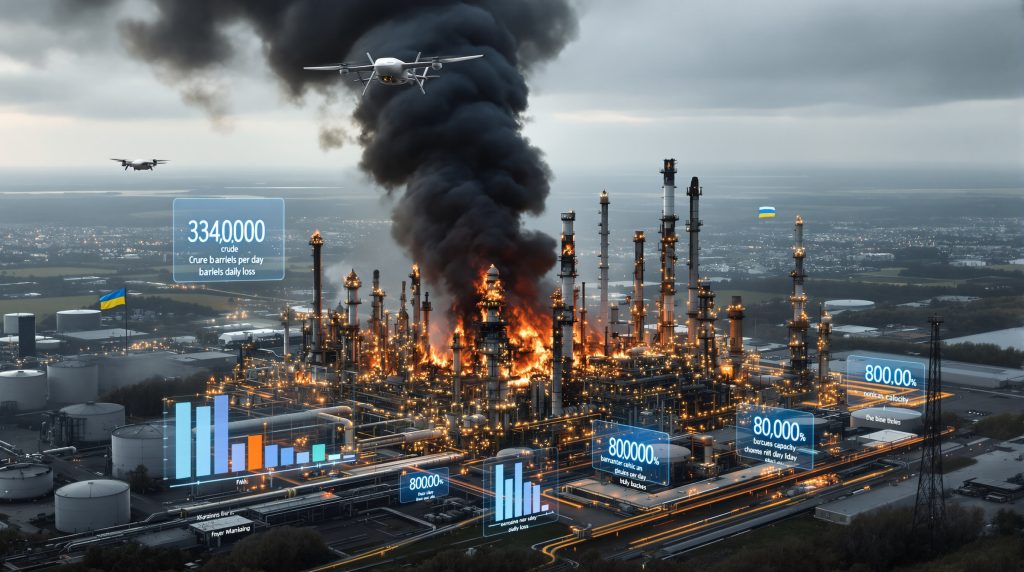Strategic Targeting of Russia's Energy Infrastructure
Ukraine strikes Russia's fourth-largest refinery represents a significant escalation in targeting critical energy infrastructure deep within Russian territory. This facility, located approximately 200 kilometres southeast of Moscow, processes over 340,000 barrels of crude oil daily, making it one of Russia's most strategically important refineries.
The precision strike on Ryazan demonstrates Ukraine's evolving capabilities to project power far beyond the immediate conflict zone. Furthermore, it targets assets that directly support Russia's war economy and military logistics networks, particularly as oil price movements continue to influence global market dynamics.
Understanding the Ryazan Refinery's Strategic Importance
The Ryazan refinery, owned by state energy giant Rosneft, ranks as Russia's fourth-largest refining facility by processing capacity. Its strategic significance extends far beyond simple production numbers, especially considering current oil price stagnation affecting global markets.
Key Facility Specifications
- Daily processing capacity: 340,000 barrels per day
- Annual throughput: Approximately 17 million tons of crude oil
- Primary markets: Moscow region fuel supply and military logistics
- Ownership: Rosneft (state-controlled entity)
- Geographic advantage: Central location for distribution throughout western Russia
The facility's proximity to Moscow makes it a critical supplier for both civilian fuel needs and military operations. Consequently, its disruption creates cascading effects throughout Russia's energy distribution network, particularly affecting fuel supplies to the capital region during peak demand periods.
Damage Assessment and Operational Impact
The Ukrainian strike specifically targeted the refinery's Crude Distillation Unit 4 (CDU-4), demonstrating sophisticated intelligence gathering and tactical planning. This precision targeting maximised operational disruption whilst minimising collateral damage.
Primary Systems Affected
| Unit | Capacity Impact | Processing Loss | Strategic Significance |
|---|---|---|---|
| CDU-4 | 4 million tons/year | 80,000 bpd | 25% of total facility capacity |
| Reformer Unit | Gasoline enhancement | Variable output | Premium fuel production |
| Hydrotreater | Diesel processing | Reduced quality | Military fuel specifications |
| Catalytic Cracker | Heavy oil conversion | Limited flexibility | Product optimisation |
The targeting of CDU-4 specifically created maximum disruption, as this unit processes approximately one-quarter of the facility's total crude throughput. In addition, the interconnected nature of refinery operations means damage to one critical unit often forces shutdown of related systems.
Cascading Operational Effects
The strike's impact extended beyond immediate physical damage:
- Complete CDU-4 shutdown: Fire damage requiring extensive repairs
- Secondary unit disruptions: Interconnected systems forced offline
- Product quality issues: Reduced ability to meet military fuel specifications
- Distribution network strain: Alternative supply routes activated at higher costs
Economic and Strategic Implications
Ukraine strikes Russia's fourth-largest refinery as part of systematic targeting of Russian energy infrastructure, representing economic warfare designed to erode Moscow's ability to fund continued military operations. The Ryazan strike fits within this broader strategic framework, particularly as OPEC market influence shapes global supply responses.
Financial Impact Analysis
The operational disruption at Ryazan creates multiple economic pressures:
- Revenue reduction: Approximately $8-12 million daily in lost processing capacity
- Increased costs: Emergency repairs and enhanced security measures
- Market volatility: Regional fuel price fluctuations
- Hard currency impact: Reduced export capacity affecting foreign exchange earnings
Furthermore, according to Reuters analysis, the facility represents a critical component of Russia's refining capacity.
Industry Insight: Refinery repairs typically require 3-6 months for major equipment replacement, with specialised components potentially facing longer lead times due to international sanctions affecting procurement channels.
Military Logistics Consequences
The strike's timing and location created specific challenges for Russian military operations:
- Fuel supply constraints: Reduced availability of military-grade refined products
- Logistics complexity: Increased transportation costs and delivery delays
- Strategic vulnerability: Exposure of critical infrastructure to long-range attacks
- Resource allocation: Diversion of defensive assets to protect energy facilities
Evolution of Ukrainian Strike Capabilities
The Ryazan attack demonstrates significant advancement in Ukraine's deep-strike capabilities compared to early 2024 operations. This evolution reflects both technological improvements and strategic doctrine development, particularly amid broader US-China trade war impact on global supply chains.
Operational Progression Analysis
Early 2024 Characteristics:
- Limited range engagements near border regions
- Opportunistic targeting of available facilities
- Tactical rather than strategic objectives
- Conventional military targets prioritised
October 2024 Capabilities:
- Deep penetration into Russian heartland (200+ km)
- Precision targeting of high-value economic assets
- Intelligence-driven infrastructure selection
- Coordinated economic warfare strategy
Intelligence and Planning Requirements
The precision of the Ryazan strike indicates sophisticated intelligence capabilities:
- Facility blueprints: Detailed knowledge of refinery layout and critical systems
- Operational timing: Strike conducted during peak processing periods
- Weather considerations: Optimal conditions for drone navigation and target acquisition
- Defensive assessment: Understanding of Russian air defence coverage gaps
Regional Energy Market Disruptions
The strike's impact on regional energy markets extends beyond immediate production losses. However, it creates uncertainty that affects pricing and supply chain planning across Eastern Europe, contributing to broader concerns about oil price crash analysis scenarios.
Market Response Indicators
- Price volatility: Regional refined product prices increased 3-5% following the strike
- Supply diversification: Accelerated efforts to source alternative fuel supplies
- Infrastructure risk premiums: Insurance costs for energy facilities increased
- Investment hesitation: Reduced confidence in Russian energy infrastructure projects
Long-term Strategic Consequences
The systematic targeting of Russian energy infrastructure creates vulnerabilities that extend far beyond immediate operational disruptions. These attacks force fundamental changes in how Russia approaches energy security.
Infrastructure Vulnerability Assessment
Geographic Exposure Factors:
- Major refineries located within extended drone strike range
- Air defence systems stretched across vast territorial expanses
- Critical facilities concentrated in economically important regions
- Limited redundancy in processing capacity for specific product types
Defensive Resource Allocation:
- Increased security spending reducing operational margins
- Personnel deployment away from offensive military operations
- Technology investment in air defence systems
- Hardening of critical infrastructure increasing construction costs
Adaptation Strategies Under Development
Russian energy sector responses to continued infrastructure threats include:
- Capacity redundancy: Investment in backup processing facilities
- Geographic dispersal: Evaluation of relocating critical operations
- Enhanced security protocols: Multi-layered defensive systems implementation
- Alternative logistics: Development of pipeline and rail alternatives to road transport
International Energy Security Implications
Ukraine strikes Russia's fourth-largest refinery demonstrates how modern conflicts increasingly target economic infrastructure. Consequently, this creates new paradigms for energy security planning globally.
Global Market Considerations
Supply Chain Resilience:
- Energy markets adapting to persistent infrastructure risks
- Alternative sourcing strategies accelerated across consuming nations
- International cooperation on strategic reserve coordination
- Investment patterns shifting toward diversified supply sources
Geopolitical Risk Pricing:
- Continued uncertainty in refined product availability
- Risk premiums incorporated into long-term energy contracts
- Insurance market reassessment of coverage for conflict zones
- Investment capital flowing toward politically stable energy producers
Technical Analysis of Strike Methodology
The precision demonstrated in the Ryazan attack suggests advanced planning and execution capabilities that represent significant tactical evolution. Moreover, Ukrainian defence reports indicate sophisticated targeting capabilities.
Weapon System Assessment
Likely Platform Characteristics:
- Long-range unmanned aerial vehicle (UAV) deployment
- GPS and inertial navigation systems for precision targeting
- Explosive payload optimised for industrial infrastructure
- Electronic warfare resistance capabilities
Navigation and Targeting:
- Pre-programmed flight paths avoiding known air defence zones
- Terminal guidance systems for final target approach
- Timing coordination to maximise operational impact
- Backup targeting options for mission flexibility
Repair Timeline and Recovery Challenges
The complexity of refinery repairs, particularly for critical distillation units, creates extended vulnerability periods. Furthermore, these compound the strategic impact of such strikes.
Recovery Phase Analysis
Immediate Response (0-30 days):
- Damage assessment and safety stabilisation
- Emergency procurement of replacement equipment
- Workforce mobilisation for repair operations
- Alternative supply arrangement activation
Reconstruction Phase (30-180 days):
- Specialised equipment delivery and installation
- System integration and testing procedures
- Regulatory approval and safety certification
- Gradual capacity restoration and optimisation
Long-term Adaptation (6+ months):
- Enhanced security system installation
- Operational procedure modifications
- Redundancy system implementation
- Supply chain diversification completion
The extended timeline for full operational recovery means that successful infrastructure strikes create lasting strategic advantages. In addition, these persist well beyond immediate physical damage.
Future Implications for Energy Warfare
Ukraine strikes Russia's fourth-largest refinery establishes new precedents for acceptable targeting in modern conflict. Consequently, this could potentially influence how future conflicts approach critical infrastructure.
Strategic Doctrine Evolution
This attack represents a shift toward comprehensive economic warfare targeting:
- Revenue generation facilities: Direct impact on war funding capabilities
- Civilian-military dual-use infrastructure: Facilities serving both populations and military forces
- Psychological impact operations: Demonstrating reach into previously secure territories
- International messaging: Signalling capabilities to both allies and adversaries
Defence Industry Implications
The success of precision strikes on energy infrastructure will likely drive:
- Enhanced air defence development: Systems specifically designed for UAV threats
- Infrastructure hardening technologies: Physical protection for critical facilities
- Early warning systems: Advanced detection capabilities for incoming threats
- Rapid repair capabilities: Modular systems enabling faster recovery from attacks
The Ryazan refinery strike exemplifies the evolution of modern warfare into comprehensive campaigns targeting the economic foundations of military capability. As Ukraine continues demonstrating the ability to project power deep into Russian territory, the strategic calculus for protecting critical infrastructure undergoes fundamental reassessment.
This development signals a new phase of conflict where economic targets become as strategically important as traditional military objectives. Furthermore, it reshapes how nations approach both offensive capabilities and defensive preparations in an interconnected global energy system.
Looking to Capitalise on Energy Market Volatility?
Discovery Alert's proprietary Discovery IQ model delivers real-time alerts on significant mineral discoveries across the ASX, helping investors navigate market turbulence with precision-timed opportunities. Whilst geopolitical events create uncertainty in traditional energy markets, strategic mineral discoveries can offer alternative pathways to capitalise on shifting commodity demands and supply chain disruptions.




